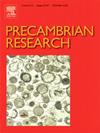Spatial U-Pb age distribution in botryoidal dolomite in the terminal Ediacaran Dengying Formation, South China: Constraints on “dolomite seas” and formation process
IF 3.2
2区 地球科学
Q2 GEOSCIENCES, MULTIDISCIPLINARY
引用次数: 0
Abstract
Widespread fibrous dolomite cements in upper Ediacaran Dengying Formation’s botryoidal dolomite were traditionally thought to form through secondary processes, but recent studies indicate they were likely the direct products of unique “dolomite seas” conditions. To elucidate botryoidal dolomite’s formation and the unique “dolomite seas,” it’s vital to date the age variability in its dolomite cements via absolute methods. In this study, we performed the first comprehensive geochronological and geochemical (C-O-Sr-REE) analyses on a representative botryoidal dolomite hand specimen PTHB-1, which is divisible into three distinct components: microbialite matrix, fibrous marine dolomite, and crystalline dolomite. Through in-situ laser-ablation ICP-MS U-Pb analyses of 720 meticulously selected laser spots across the specimen, we obtained a dataset of 14 U-Pb age determinations for the various dolomite cements. Notably, ten laminae of U-enriched fibrous dolomite cements yielded ten high-precision U-Pb ages bracketing a time range between 550.1 ± 8.0 Ma and 542 ± 14 Ma (weighted mean 546.8 ± 3.2 Ma), aligning chronologically with the stratigraphic age interval (551.1–542 Ma). These findings, coupled geochemical signatures and petrographic evidence, suggest that the fibrous dolomite cements were initially direct marine precipitates, challenging previous secondary genetic interpretations. This revelation points to a short-lived “dolomite sea” existed in the terminal Ediacaran Ocean in the upper Yangtze region. Conversely, the later stages of vug-filling crystalline dolomite cements exhibit pronounced positive Eu and Y anomalies along with lower δ13C and δ18O, indicating hydrothermal fluid precipitation. Our results reveal at least three phases of crystalline dolomite cements at ca. 411 ± 17 Ma, 358.7 ± 6.1 Ma, and 257.2 ± 8.4 Ma, respectively, contributing significantly to the modification of reservoir properties. The insights gleaned from this research provide crucial chronological data for comprehending the formation and evolutionary history of botryoidal dolomite reservoirs, with substantial implications for hydrocarbon exploration efforts.
求助全文
约1分钟内获得全文
求助全文
来源期刊

Precambrian Research
地学-地球科学综合
CiteScore
7.20
自引率
28.90%
发文量
325
审稿时长
12 months
期刊介绍:
Precambrian Research publishes studies on all aspects of the early stages of the composition, structure and evolution of the Earth and its planetary neighbours. With a focus on process-oriented and comparative studies, it covers, but is not restricted to, subjects such as:
(1) Chemical, biological, biochemical and cosmochemical evolution; the origin of life; the evolution of the oceans and atmosphere; the early fossil record; palaeobiology;
(2) Geochronology and isotope and elemental geochemistry;
(3) Precambrian mineral deposits;
(4) Geophysical aspects of the early Earth and Precambrian terrains;
(5) Nature, formation and evolution of the Precambrian lithosphere and mantle including magmatic, depositional, metamorphic and tectonic processes.
In addition, the editors particularly welcome integrated process-oriented studies that involve a combination of the above fields and comparative studies that demonstrate the effect of Precambrian evolution on Phanerozoic earth system processes.
Regional and localised studies of Precambrian phenomena are considered appropriate only when the detail and quality allow illustration of a wider process, or when significant gaps in basic knowledge of a particular area can be filled.
 求助内容:
求助内容: 应助结果提醒方式:
应助结果提醒方式:


